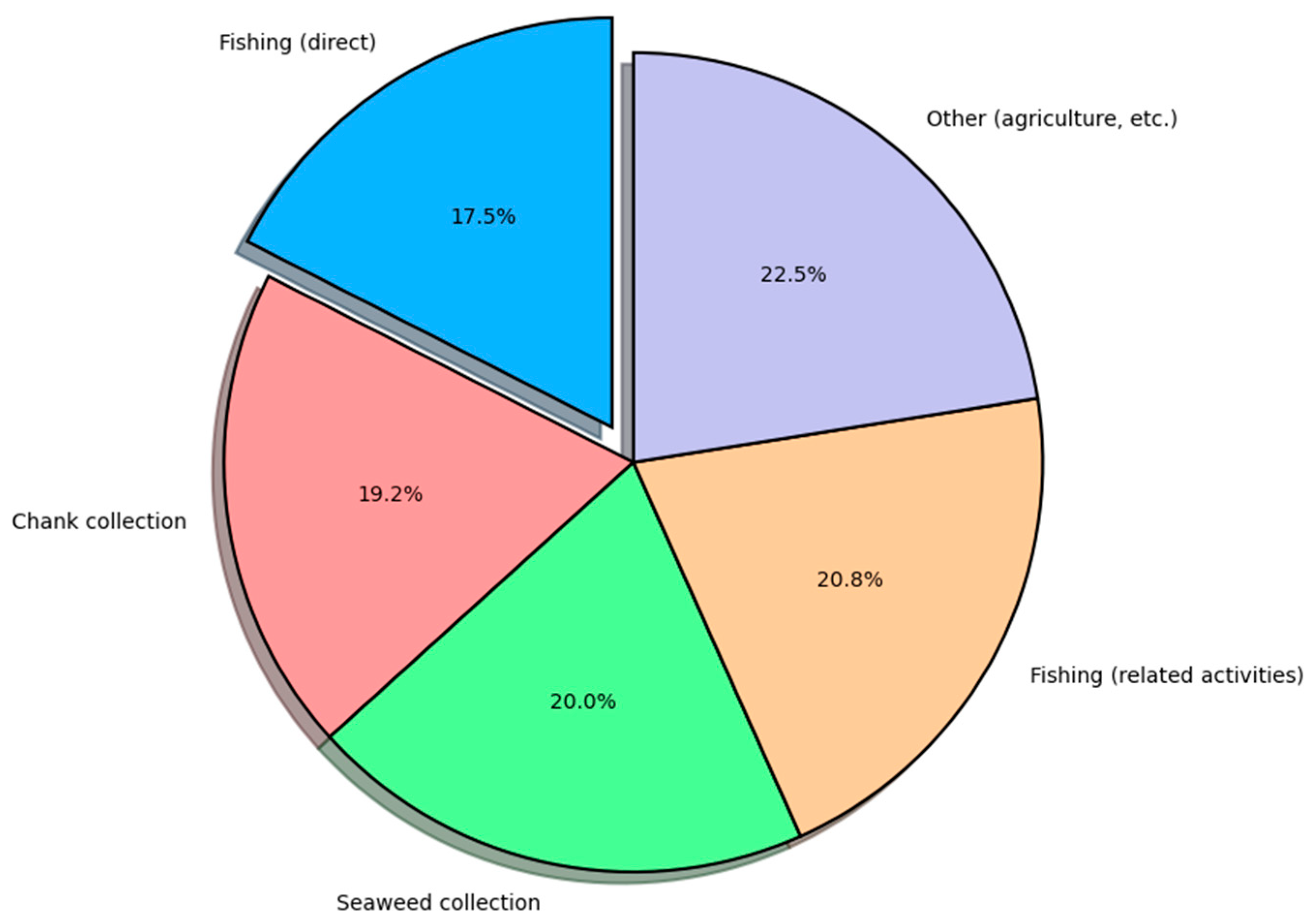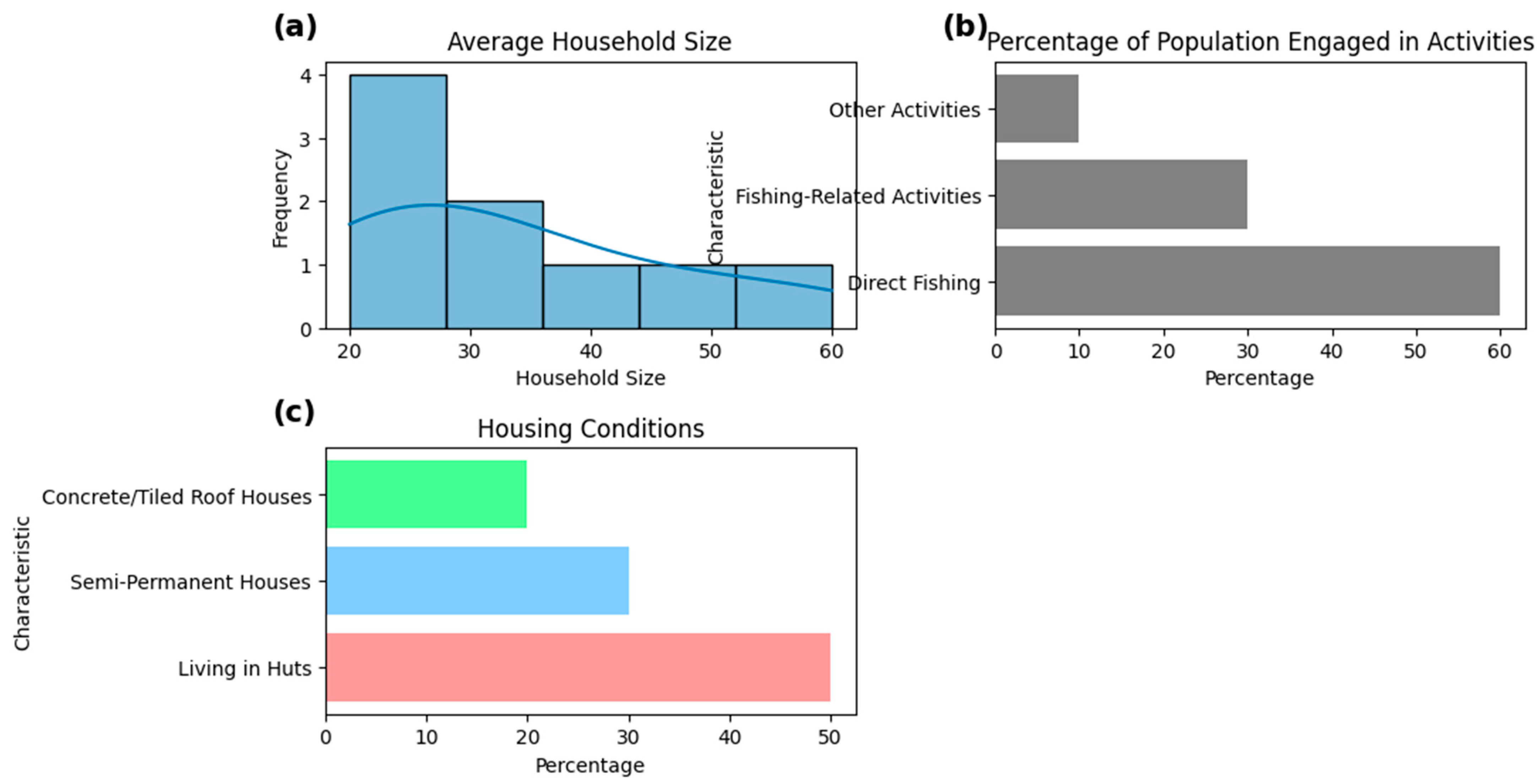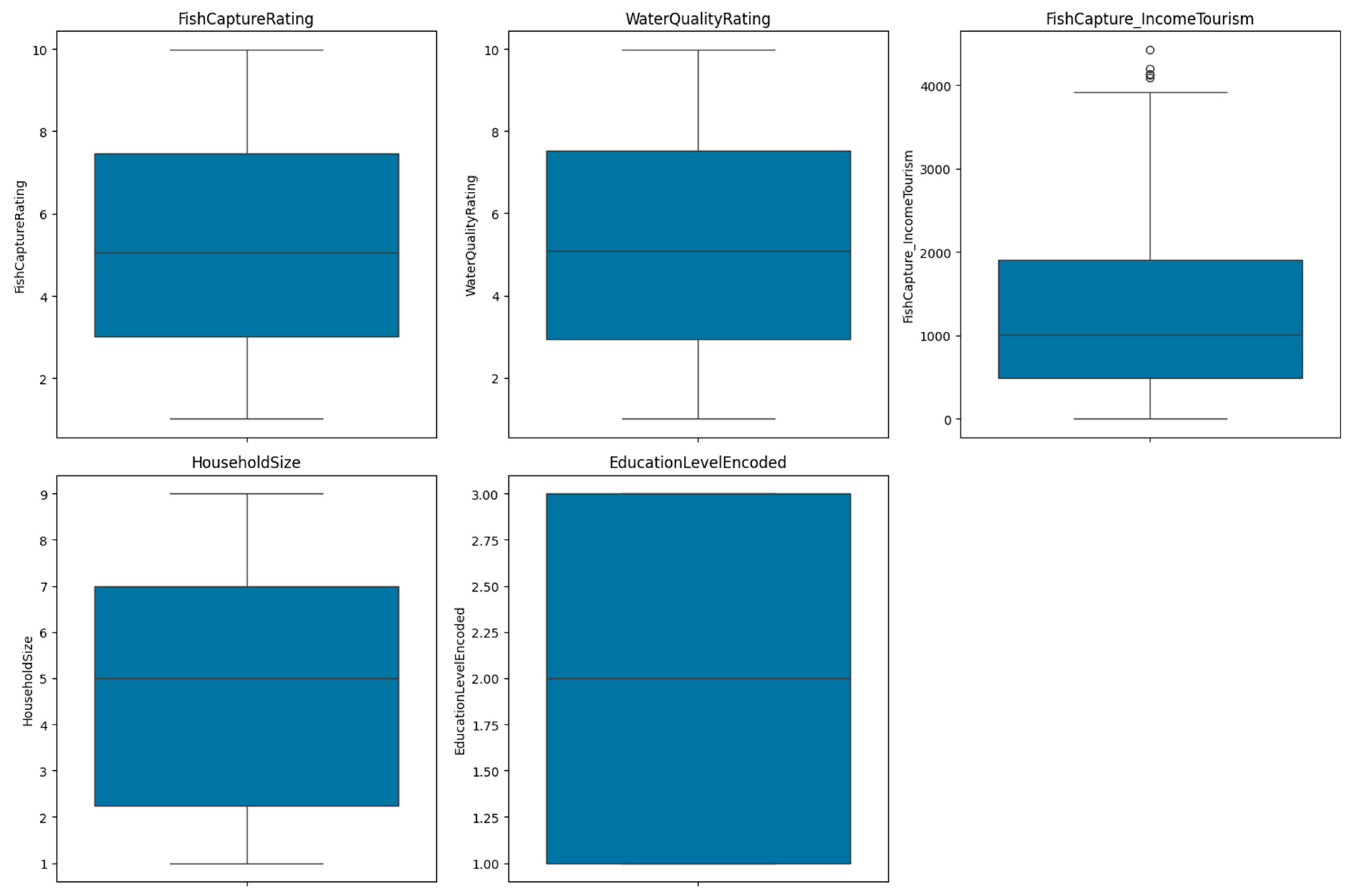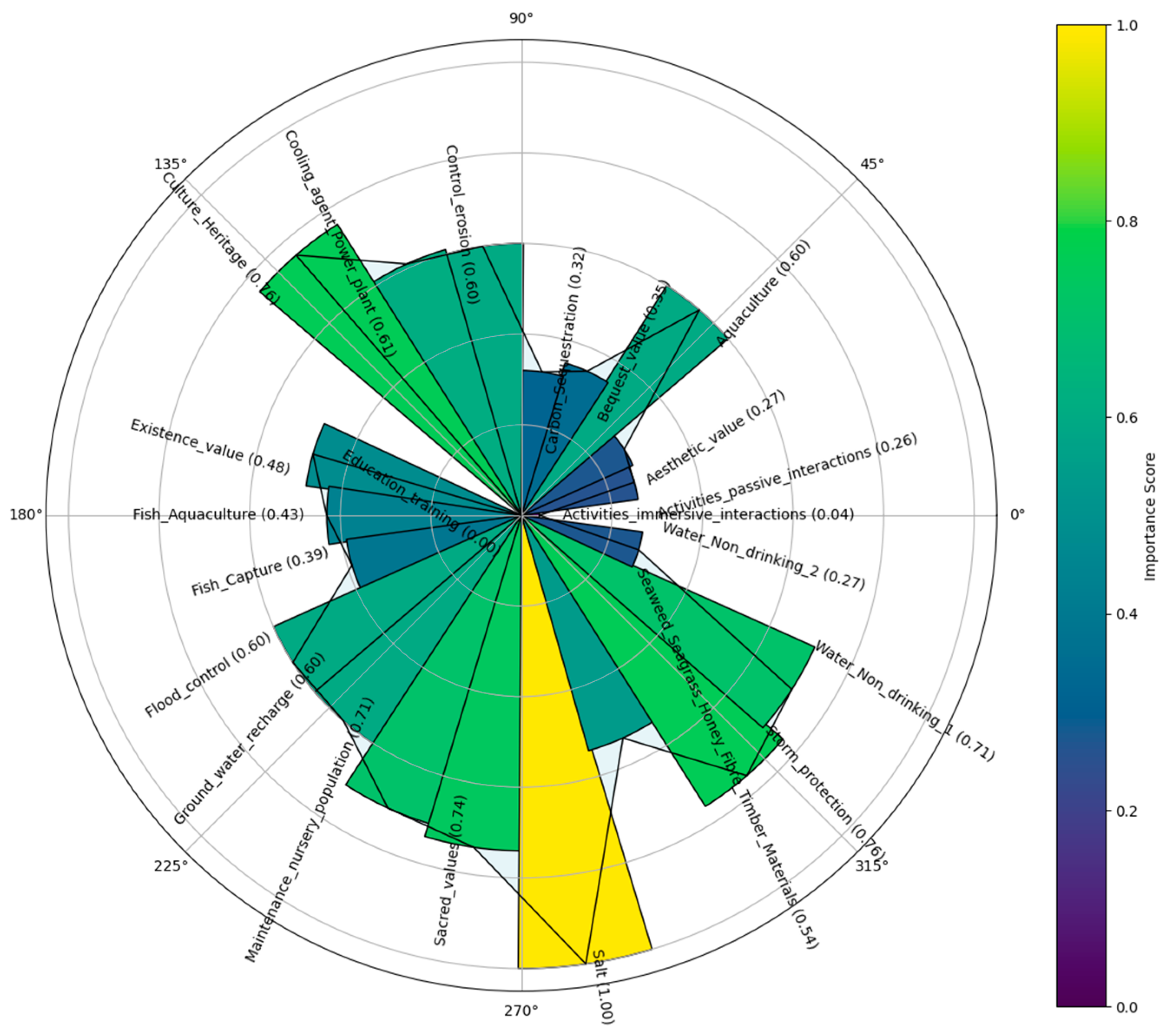Balancing Nets and Lives: A Socio-Ecological Analysis of Sustainable Fisheries on the Indian Coast of the Gulf of Mannar
Abstract
1. Introduction
1.1. Problem Statement
1.2. Research Objectives
2. Material and Methods
2.1. Description of the Study Area
2.2. Demographic and Socio-Economic Profile
2.3. Survey and Data Collection
2.4. Statistical Techniques
2.4.1. Multiple Regression Analysis
2.4.2. Logistic Regression
3. Results and Discussion
4. Conclusions and Recommendations
Author Contributions
Funding
Informed Consent Statement
Data Availability Statement
Conflicts of Interest
References
- FAO. The State of World FIsheries and Aquaculture 2020: Sustainability in Action; Food and Agriculture Organization of the United Nations: Rome, Italy, 2020. [Google Scholar]
- Worm, B.; Hilborn, R.; Baum, J.K.; Branch, T.A.; Collie, J.S.; Costello, C.; Fogarty, M.J.; Fulton, E.A.; Hutchings, J.A.; Jennings, S.; et al. Rebuilding global fisheries. Science 2009, 325, 578–585. [Google Scholar] [CrossRef] [PubMed]
- Pikitch, E.K.; Santora, C.; Babcock, E.A.; Bakun, A.; Bonfil, R.; Conover, D.O.; Dayton, P.; Doukakis, P.; Fluharty, D.; Heneman, B.; et al. Ecosystem-based fishery management. Science 2004, 303, 346–347. [Google Scholar] [CrossRef] [PubMed]
- CCMFR. Gulf of Mannar Biosphere Reserve; Committee for Coordination of Mediterranean Forestry Research: Rome, Italy, 2019. [Google Scholar]
- Bennett, N.J.; Blythe, J.; White, C.S.; Campero, C. Blue growth and blue justice: Ten risks and solutions for the ocean economy. Mar. Policy 2019, 100, 249–258. [Google Scholar] [CrossRef]
- McClanahan, T.; Allison, E.H.; E Cinner, J. Managing fisheries for human and food security. Fish Fish. 2015, 16, 78–103. [Google Scholar] [CrossRef]
- Barbier, E. Valuing Ecosystem Services for Coastal Wetland Protection and Restoration: Progress and Challenges. Resources 2013, 2, 213–230. [Google Scholar] [CrossRef]
- Navjot, D.; Srinivasan, R. Resilience of fishing communities to climate change: A case study from Gulf of Mannar. Fish. Res. 2022, 145, 232–241. [Google Scholar]
- Vivekanandan, E.; Reddy, K.R.; Rajkumar, M. Decline in marine fish catch rates along the Indian coast: An overview. J. Mar. Res. 2005, 63, 781–803. [Google Scholar]
- Hernández, A.; Caballero, R.; León, M.A.; Casas, M.; Pérez, V.E.; Silva, C.L. Multi-Criteria Decision Modeling for Environmental Assessment. An Estimation of Total Economic Value in Protected Natural Areas. Int. J. Environ. Res. 2014, 8, 551–560. [Google Scholar]
- Bavinck, M.; Berkes, F.; Charles, A.; Dias, A.C.E.; Doubleday, N.; Nayak, P.; Sowman, M. The impact of coastal grabbing on community conservation—A global reconnaissance. Marit. Stud. 2017, 16, 8. [Google Scholar] [CrossRef]
- Sousa, I. Gender roles in fisheries co-management: Insights from the Gulf of Mannar, India. Mar. Policy 2018, 94, 174–181. [Google Scholar]
- MEA. Ecosystems and Human Well-Being: Synthesis; Island Press: Washington, DC, USA, 2005. [Google Scholar]
- Jentoft, S.; McCay, B.J.; Wilson, D.C. Social theory and fisheries co-management. Mar. Policy 1998, 22, 423–436. [Google Scholar] [CrossRef]
- McCay, B.J. Emergence of institutions for the commons: Contexts, situations, and events. In The Drama of the Commons; National Academy of Science: Washington, DC, USA, 2002; pp. 361–402. [Google Scholar]
- Costanza, R.; d’Arge, R.; de Groot, R.; Farber, S.; Grasso, M.; Hannon, B.; Limburg, K.; Naeem, S.; O’Neill, R.V.; Paruelo, J.; et al. The value of the world’s ecosystem services and natural capital. Nature 1997, 387, 253–260. [Google Scholar] [CrossRef]
- Berkes, F.; Mahon, R.; McConny, P.; Pollnac, R.; Pomeroy, R. Managing Small-Scale Fisheries: Alternative Directions and Methods; IDRC: Ottawa, ON, Canada, 2001. [Google Scholar]
- Kumaraguru, A.K.; Joseph, V.E.; Marimuthu, N.; Wilson, J.J. Scientific Information on Gulf of Mannar Bibliography; Madurai Kamaraj University: Tamil Nadu, India, 2006. [Google Scholar]
- Venkataraman, K.; Raghunathan, C. Coastal and Marine Biodiversity of India. In Marine Faunal Diversity in India; Academic Press: Cambridge, MA, USA, 2015; pp. 303–348. [Google Scholar]
- UNESCO. Gulf of Mannar Biosphere Reserve, India; UNESCO: Paris, France, 2023. [Google Scholar]
- Mukhopadhyay, R.; Loveson, V.J.; Iyer, S.D.; Sudarson, P.K. Blue Economy of the Indian Ocean: Resource Economics, Strategic Vision, and Ethical Governance; CRC Press: Boca Raton, FL, USA, 2020. [Google Scholar]
- DOF. Fish Production Statistics; Government of Tamil Nadu: Tamil Nadu, India, 2022. [Google Scholar]
- Gopal, B. Future of wetlands in tropical and subtropical Asia, especially in the face of climate change. Aquat. Sci. 2013, 75, 39–61. [Google Scholar] [CrossRef]
- Krishnakumar, B.; Rajan, P.S.; Venkatesh, N. Diversifying livelihoods in coastal regions: Lessons from seaweed farming and ecotourism. Coast. Manag. 2021, 49, 189–206. [Google Scholar]
- Parrao, C.G.; Moratti, M.; Shisler, S.; Snilstveit, B.; Eyers, J. PROTOCOL: Aquaculture for improving productivity, income, nutrition and women’s empowerment in low- and middle-income countries: A systematic review and meta-analysis. Campbell Syst. Rev. 2021, 17, e1188. [Google Scholar] [CrossRef]
- KaviKumar, K.S.; Anneboina, L.R.; Bhatta, R.; Naren, P.; MeghaNath; Sharan, A.; Mukhopadhyay, P.; Ghosh, S.; daCosta, V.; Pednekar, S. Valuation of Coastal and Marine Ecosystem Services in India: Macro Assessment; Madras School of Economics: Tamil Nadu, India, 2016. [Google Scholar]
- Manikandan, B.; Ravindran, J.; Vidya, P.J.; Shrinivasu, S.; Manimurali, R.; Paramasivam, K. Resilience potential of an Indian Ocean reef: An assessment through coral recruitment pattern and survivability of juvenile corals to recurrent stress events. Environ. Sci. Pollut. Res. 2017, 24, 13614–13625. [Google Scholar] [CrossRef]
- Sundaram, S.L.P.; Radhakrishnan, K.; Narayanakumar, R.; P, V.K.V.; Surya, S.; Divu, D.; Gopal, N.; Kingsly, J.; Leslie, V.; Mojjada, S.K.; et al. Energy efficiency and economics of small-scale fisheries (SSF) in India: A VIKOR based multicriteria decision-making model for sustainable fisheries management. J. Clean. Prod. 2024, 450, 141864. [Google Scholar] [CrossRef]
- Bradnock, R.W. Patterns of Rural Development in Tamil Nadu; University of London, School of Oriental and African Studies: London, UK, 1977. [Google Scholar]
- Magesh, N.S.; Krishnakumar, S. The Gulf of Mannar marine biosphere reserve, southern India. In World Seas: An Environmental Evaluation; Academic Press: Cambridge, MA, USA, 2019; pp. 169–184. [Google Scholar]
- Sathiadhas, R.; Prathap, K.S. Employment scenario and labour migration in marine fisheries. Asian Fish. Sci. 2009, 22, 713–727. [Google Scholar] [CrossRef]
- Nayak, P.; Berkes, F.; Charles, A. Conservation for whom? : Indigenous people and resource governance in the Sundarbans, India. Conserv. Soc. 2016, 14, 128–139. [Google Scholar]
- Rengasamy, S.; Devavaram, J.; Prasad, R.; Arunodaya, E. A case study from the Gulf of Mannar. Poverty Reefs 2003, 2, 113–146. [Google Scholar]
- Adger, W.N. Social vulnerability to climate change and extremes in coastal Vietnam. World Dev. 1999, 27, 249–269. [Google Scholar] [CrossRef]
- Power, N.G. Women, Processing Industries and the Environment: A Sociological Analysis of Women Fish and Crab Processing Workers’ Local Ecological Knowledge; Memorial University of Newfoundland: St. John’s, NL, Canada, 1997. [Google Scholar]
- Rahman, M.M.; Chowdhury, Z.A.; Sada, N.U. Coastal Resources Management, Policy and Planning in Bangladesh; WorldFish: Penang, Malaysia, 2003. [Google Scholar]
- Narayanakumar, R.; Krishnan, M. Socio-economic assessment of seaweed farmers in Tamil Nadu—A case study in Ramanathapuram District. Indian J. Fish. 2013, 60, 51–57. [Google Scholar]
- Joshi, K.K.; Narayanakumar, R.; Varghese, M.; Vinod, K.; Jasmine, S.; Sreeram, M.P.; Sreenath, K.R.; Sethulakshmi, M.; Thobias, P.A.; Raju, A.K.; et al. Fisheries valuation in the coastal and marine ecosystems of Kerala, India. In Proceedings of the 11th Indian Fisheries and Aquaculture Forum, Kerala, India, 21–24 November 2017. [Google Scholar]
- Rajagopalan, R. Handbook on Convention on Biological Diversity (CBD) for Small-Scale Fishing Communities; International Collective in Support of Fishworkers (ICSF): Tamil Nadu, India, 2022. [Google Scholar]
- Rajeev, M.; Bhandarkar, S. Unravelling Supply Chain Networks of Fisheries in India: The Transformation of Retail; Springer Nature: Berlin/Heidelberg, Germany, 2022. [Google Scholar]
- Hair, J.F.; Black, W.C.; Babin, B.J.; Anderson, R.E. Multivariate Data Analysis, 7th ed.; Pearson: London, UK, 2014. [Google Scholar]
- Aiken, L.S.; West, S.G. Multiple Regression: Testing and Interpreting Interactions; SAGE Publications: Thousand Oaks, CA, USA, 1991. [Google Scholar]
- Field, A. Discovering Statistics Using IBM SPSS Statistics, 4th ed.; SAGE Publications: Thousand Oaks, CA, USA, 2013. [Google Scholar]
- Hosmer, D.W.; Lemeshow, S.; Sturdivant, R.X. Applied Logistic Regression, 3rd ed.; Wiley: Hoboken, NJ, USA, 2013. [Google Scholar]
- Peng, C.Y.J.; Lee, K.L.; Ingersoll, G.M. An introduction to logistic regression analysis and reporting. J. Educ. Res. 2002, 96, 3–14. [Google Scholar] [CrossRef]
- Hoegh-Guldberg, O.; Veron, J.E.N.; Green, A.; Gomez, E.D.; Ambariyanto, A.; Hansen, L. The Coral Triangle and Climate Change: Ecosystems, People and Societies at Risk; WWF Australia: Brisbane, Australia, 2009. [Google Scholar]
- Islam, S.; Kibria, M.G. Housing vulnerability and environmental hazards in coastal Bangladesh. J. Environ. Manag. 2018, 230, 236–244. [Google Scholar]
- Miller, R.; Atkinson, P. Gender roles and sustainable fisheries in Southeast Asia. Mar. Policy 2023, 142, 105115. [Google Scholar]
- Miller, I.; Grant, W.S.; Collins, M.; Covi, M.; Gassett, P.; Abeels, H.; Alvarez, K.; Barrett, J.; Barry, S.; Behl, M.; et al. Sea Grant Programs Build Resilience to Coastal Climate Hazards. Oceanography 2024, 37, 108–115. [Google Scholar] [CrossRef]
- Jones, A.; Brown, T. Household well-being in resource-dependent communities. World Dev. 2019, 116, 207–222. [Google Scholar]
- Kumar, R.; Parikh, J.; Rao, P. Community well-being in coastal and marine ecosystems. Environ. Sci. Policy 2022, 132, 54–65. [Google Scholar]
- Pascual, U.; Muradian, R.; Brander, L.; Gómez-Baggethun, E.; Martín-López, B.; Verma, M.; Armsworth, P.; Christie, M.; Cornelissen, H.; Eppink, F.; et al. The economics of valuing ecosystem services and biodiversity. In The Economics of Ecosystems and Biodiversity: Ecological and Economic Foundations; Routledge: Abingdon-on-Thames, UK, 2012; pp. 183–256. [Google Scholar]
- Costanza, R.; De Groot, R.; Sutton, P.; Van der Ploeg, S.; Anderson, S.J.; Kubiszewski, I.; Farber, S.; Turner, R.K. Changes in the global value of ecosystem services. Glob. Environ. Change 2014, 26, 152–158. [Google Scholar] [CrossRef]
- Wildenberg, M. Ecology, Rituals and System-Dynamics. In An Attempt to Model the Socio-Ecological System of Trinket Island; Social Ecology Working Paper 80; IFF Social Ecology: Vienna, Austria, 2005. [Google Scholar]
- Umamaheswari, T.; Sugumar, G.; Krishnan, P.; Ananthan, P.S.; Anand, A.; Jeevamani, J.J.J.; Mahendra, R.S.; Infantina, J.A.; Rao, C.S. Vulnerability assessment of coastal fishing communities for building resilience and adaptation: Evidences from Tamil Nadu, India. Environ. Sci. Policy 2021, 123, 114–130. [Google Scholar] [CrossRef]
- Carter, M.; Barrett, C.B.; Little, P.D. Food security and socioeconomic dynamics. J. Agric. Econ. 2019, 70, 789–812. [Google Scholar]
- Salagrama, V. The socio-economic impact of household size and resource strain in small-scale fishing communities. Mar. Policy 2015, 53, 68–76. [Google Scholar]
- Ostrom, E. Governing the Commons: The Evolution of Institutions for Collective Action; Cambridge University Press: Cambridge, UK, 1990. [Google Scholar]
- Berkes, F. Traditional ecological knowledge in perspective. In Traditional Ecological Knowledge: Concepts and Cases; Canadian Museum of Nature: Ottawa, ON, Canada, 1993. [Google Scholar]





| Index | Ecosystem Service | Average Rating | Comment on Data Interpretation |
|---|---|---|---|
| 0 | Fish capture | 3.045833 | Critical for both traditional and industrial fisheries. |
| 1 | Fish aquaculture | 3.079167 | Needs emphasis on results, key for industrial fisheries. |
| 2 | Salt | 2.991667 | Provides moderate value to both fisheries, with industrial higher use. |
| 3 | Seaweed, seagrass, honey, fibre, timber, materials | 3.070833 | Relevant to traditional livelihoods; should be discussed separately. |
| 4 | Water non-drinking 1 (Industrial use) | 3.029167 | Likely related to industrial uses (e.g., cooling, processing). |
| 5 | Aquaculture | 3.14375 | Most importantly; the emphasis in both data sets, is stronger for industrial. |
| 6 | Water non-drinking 2 (Ecological services) | 3.091667 | Relates to ecological value, and a stronger impact on traditional fisheries. |
| 7 | Cooling agent for power plants | 2.983333 | Important for industrial use but less so for traditional. |
| 8 | Carbon sequestration | 2.9625 | Important but has even weight in both fisheries. |
| 9 | Control erosion | 2.985417 | Significant for both groups, particularly those dependent on mangroves. |
| 10 | Flood control | 3.085417 | Important for coastal protection, especially for traditional fishers. |
| 11 | Maintenance of the nursery population | 3.014583 | Relevant for both fisheries and more critical for traditional. |
| 12 | Groundwater recharge | 2.895833 | Moderate importance, particularly for ecological services. |
| 13 | Storm protection | 2.9625 | High relevance for communities in traditional fisheries. |
| 14 | Activities (immersive interactions) | 3.079167 | Direct engagement like tourism; has more value in industrial areas. |
| 15 | Activities (passive interactions) | 2.90625 | Indirect value is important for cultural/ecological services. |
| 16 | Education and training | 3.04375 | Benefits both sectors, particularly in sustainable practices. |
| 17 | Culture and heritage | 2.975 | More valued by traditional communities due to cultural ties. |
| 18 | Aesthetic value | 2.960417 | Important for tourism; slightly stronger for industrial fisheries. |
| 19 | Sacred values | 3.002083 | Significant cultural and spiritual value, mainly for traditional groups. |
| 20 | Existence value | 3.04375 | Equally important for both fleets, reflecting broader ecological value. |
| 21 | Bequest value | 3.04375 | Reflects intergenerational importance, is equally relevant for both types. |
Disclaimer/Publisher’s Note: The statements, opinions and data contained in all publications are solely those of the individual author(s) and contributor(s) and not of MDPI and/or the editor(s). MDPI and/or the editor(s) disclaim responsibility for any injury to people or property resulting from any ideas, methods, instructions or products referred to in the content. |
© 2024 by the authors. Licensee MDPI, Basel, Switzerland. This article is an open access article distributed under the terms and conditions of the Creative Commons Attribution (CC BY) license (https://creativecommons.org/licenses/by/4.0/).
Share and Cite
Saha, D.; Kumar, D.S.; Krishnan, P.; Mukherjee, R.; Vidhyavathi, A.; Maheswari, M.; Vijayabhama, M. Balancing Nets and Lives: A Socio-Ecological Analysis of Sustainable Fisheries on the Indian Coast of the Gulf of Mannar. Sustainability 2024, 16, 8738. https://doi.org/10.3390/su16208738
Saha D, Kumar DS, Krishnan P, Mukherjee R, Vidhyavathi A, Maheswari M, Vijayabhama M. Balancing Nets and Lives: A Socio-Ecological Analysis of Sustainable Fisheries on the Indian Coast of the Gulf of Mannar. Sustainability. 2024; 16(20):8738. https://doi.org/10.3390/su16208738
Chicago/Turabian StyleSaha, Deepanjana, Devarajulu Suresh Kumar, Pandian Krishnan, Rajdeep Mukherjee, A. Vidhyavathi, M. Maheswari, and M. Vijayabhama. 2024. "Balancing Nets and Lives: A Socio-Ecological Analysis of Sustainable Fisheries on the Indian Coast of the Gulf of Mannar" Sustainability 16, no. 20: 8738. https://doi.org/10.3390/su16208738
APA StyleSaha, D., Kumar, D. S., Krishnan, P., Mukherjee, R., Vidhyavathi, A., Maheswari, M., & Vijayabhama, M. (2024). Balancing Nets and Lives: A Socio-Ecological Analysis of Sustainable Fisheries on the Indian Coast of the Gulf of Mannar. Sustainability, 16(20), 8738. https://doi.org/10.3390/su16208738







